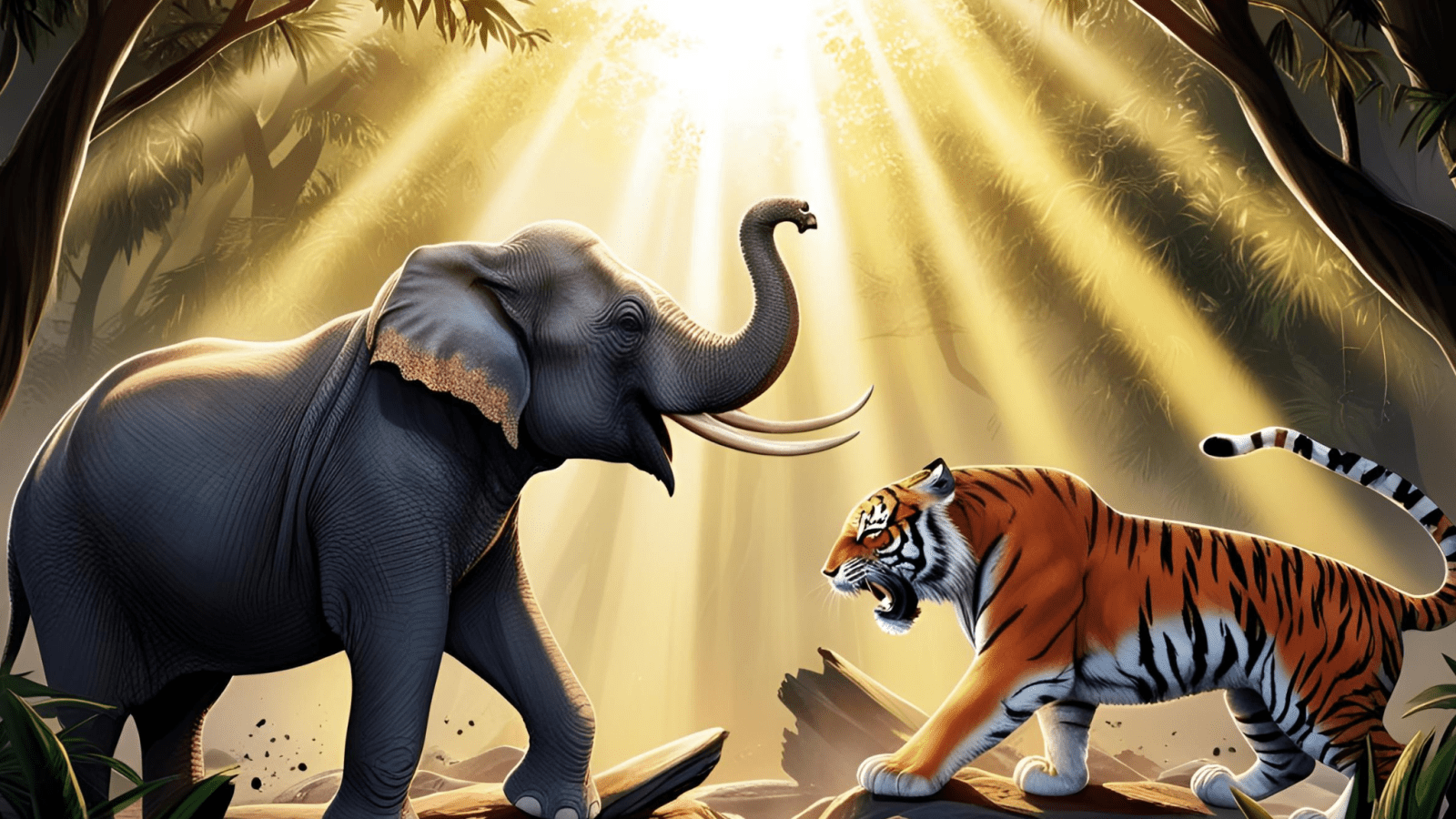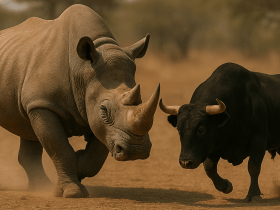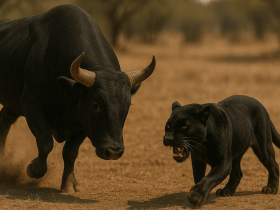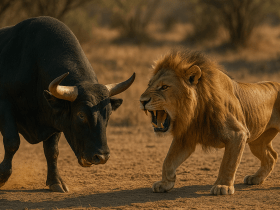Below is a full detailed article about Asian Elephant vs Tiger
Asian elephant (Elephas maximus).
Tiger (Panthera tigris)
Below tables cover 10 main topics by including all the numerical and scientifical data by comparing Asian Elephant vs Tigers . Also I have included a winner column for further understanding,
Hope you will enjoy!
1. Body Specifications
| Feature | Asian Elephant (Elephas maximus) | Tiger (Panthera tigris) | Winner |
|---|---|---|---|
| Height at Shoulder | 2.4–3.0 m (male) | 0.9–1.2 m | Elephant |
| Body Length | 5.5–6.4 m (excl. trunk) | 2.5–3.3 m (incl. tail) | Elephant |
| Weight | 2,700–6,000 kg (male) | 140–300 kg (male) | Elephant |
| Muscle Mass | Exceptionally high | High, lean | Elephant |
| Bone Density | Very high | High | Elephant |
| Trunk Power | Can lift ~300 kg | No trunk | Elephant |
| Tusks | Present in males (up to 2.5 m) | Absent | Elephant |
| Footprint Size | 40–50 cm diameter | 10–15 cm diameter | Elephant |
| Tail Length | ~1.5 m | ~1 m | Tie |
| Overall Size Dominance | Largest land mammal | Apex predator | Elephant |
Winner: Asian Elephant — A colossus in every dimension.
2. Coat and Coloration
| Feature | Asian Elephant | Tiger | Winner |
|---|---|---|---|
| Skin Color | Grey with patches of depigmentation | Orange with black stripes | Tiger |
| Hair Density | Sparse body hair | Medium density fur | Tiger |
| Camouflage Ability | Low | High (ambush camouflage) | Tiger |
| Skin Thickness | ~2.5–3 cm | ~1 cm | Elephant |
| Color Variation | Limited | Bengal, white, golden tigers | Tiger |
| Melanin Function | Minimal | Pattern-based camouflage | Tiger |
| Sweat Glands | None — cools with ears | None — pants & rests | Tie |
| Skin Function | Armor-like, insect repellant | Flexible, stealthy | Elephant |
| Coat Pattern | Wrinkled, plain | Disruptive striping | Tiger |
| Thermal Regulation | Via ears and skin folds | Via shade and water | Elephant |
Winner: Tiger — Superior stealth and adaptive coat.
3. Habitat and Range – Asian Elephant vs Tiger
| Feature | Asian Elephant | Tiger | Winner |
|---|---|---|---|
| Native Range | South, Southeast Asia | South, Southeast Asia | Tie |
| Habitat Type | Forests, grasslands | Forests, swamps | Tie |
| Territorial Range | 100–1,000 km² | 20–100 km² | Elephant |
| Altitude Tolerance | Up to 3,000 m | Up to 4,000 m | Tiger |
| Climate Tolerance | Tropical, seasonal | Tropical to sub-temperate | Tie |
| Water Dependency | High (drinks ~200 L/day) | Moderate | Elephant |
| Habitat Adaptability | Limited (requires large space) | High (dense & open terrain) | Tiger |
| Human Conflict Frequency | Very high | High | Tie |
| Migration Behavior | Seasonal migration | Resident/territorial | Elephant |
| Shelter Use | Sleeps standing or on side | Uses dens, thick brush | Tiger |
Winner: Tie — Coexist in overlapping habitats with unique adaptations.
4. Diet and Feeding Behavior
| Feature | Asian Elephant | Tiger | Winner |
|---|---|---|---|
| Diet Type | Herbivore | Carnivore | Tie |
| Daily Caloric Intake | ~50,000 kcal | ~6,000–10,000 kcal | Elephant |
| Daily Food Quantity | 150–200 kg of vegetation | 6–10 kg of meat | Elephant |
| Feeding Time per Day | ~16 hours | ~3–4 hours (post-hunt) | Elephant |
| Feeding Tools | Trunk, tusks | Teeth, claws | Tie |
| Hunting vs. Grazing | Constant grazing | Ambush predator | Tie |
| Prey/Kill Size | N/A | Can take down prey 3–5x its size | Tiger |
| Food Storage/Retention | Stores food in cheek, water in trunk | No storage | Elephant |
| Digestive Efficiency | Poor (50% digested) | Efficient carnivore digestion | Tiger |
| Foraging Intelligence | Very high (can recognize over 100 plant species) | High (tracks prey) | Elephant |
Winner: Tie — Both are masters of their feeding strategy.
5. Strength and Force – Asian Elephant vs Tiger
| Feature | Asian Elephant | Tiger | Winner |
|---|---|---|---|
| Bite Force | ~600 PSI (molar grinding) | ~1,050 PSI | Tiger |
| Lifting Strength | Can lift 300–350 kg with trunk | Can drag prey 2–3× body weight (~600–900 kg) | Elephant |
| Strike Power | Tusks + trunk combo force >4,000 N | Pounce with ~2,000 N | Elephant |
| Stomping Force | Can crush bones | Rarely uses weight this way | Elephant |
| Tusk Impact | Piercing and impaling | N/A | Elephant |
| Neck Strength | Powerful to support tusks and trunk | Strong for pulling down prey | Elephant |
| Claw Power | N/A | 7.5–10 cm curved claws | Tiger |
| Muscle Mass Distribution | Broad, for endurance and load | Lean, explosive | Tie |
| Defensive Force | Wall of muscle and tusks | Quick swipes and bites | Elephant |
| Force Endurance | Can maintain effort for hours | Short bursts only | Elephant |
Winner: Asian Elephant — Unmatched brute force and endurance.
⚡ 6. Speed and Agility – Asian Elephant vs Tiger
| Feature | Asian Elephant | Tiger | Winner |
|---|---|---|---|
| Top Speed | 25–30 km/h (charge speed) | 50–60 km/h (sprint) | Tiger |
| Acceleration | Slow build-up | Explosive | Tiger |
| Stamina | High — long distance travel | Moderate | Elephant |
| Turning Radius | Wide | Tight, agile | Tiger |
| Combat Agility | Turns slowly in close quarters | Agile pouncer | Tiger |
| Jumping Ability | Cannot jump | Can leap 5–6 m | Tiger |
| Swimming | Excellent | Excellent | Tie |
| Climbing | Cannot climb | Very good climber | Tiger |
| Crouch and Ambush | No stealth capability | World-class ambusher | Tiger |
| Maneuverability | Low | High | Tiger |
Winner: Tiger — Lightning-fast reflexes and killer agility.
️ 7. Senses – Asian Elephant vs Tiger
| Feature | Asian Elephant | Tiger | Winner |
|---|---|---|---|
| Hearing | Extremely acute; low-frequency detection | Excellent, higher frequency range | Elephant |
| Smell | Exceptional — detects water from kilometers away | Very strong — detects prey at long distances | Tie |
| Vision (Day) | Moderate | Very good | Tiger |
| Vision (Night) | Poor | Excellent (6x human) | Tiger |
| Vibration Detection | Detects ground vibrations via feet | Limited | Elephant |
| Olfactory Bulb Size | Very large | Large | Elephant |
| Facial Recognition | Recognizes over 100 individuals | Moderate | Elephant |
| Emotional Perception | Very high — empathy, mourning, bonding | Moderate | Elephant |
| Scent Marking | Minimal | Frequent | Tiger |
| Tactical Sensing | Strategic sensing via sound/smell | Predatory awareness | Tie |
Winner: Elephant — More advanced non-visual sensing.
8. Reproduction and Lifespan
| Feature | Asian Elephant | Tiger | Winner |
|---|---|---|---|
| Gestation Period | ~22 months (longest in mammals) | ~105 days | Elephant |
| Offspring per Birth | 1 calf | 2–4 cubs | Tiger |
| Birth Weight | 100 kg | 1–2 kg | Elephant |
| Parental Care Duration | Up to 10 years | ~2 years | Elephant |
| Sexual Maturity Age | 10–15 years | 3–4 years | Tiger |
| Reproductive Frequency | Every 4–6 years | Every 2–3 years | Tiger |
| Lifespan (Wild) | 48–60 years | 10–15 years | Elephant |
| Lifespan (Captivity) | Up to 70 years | Up to 20 years | Elephant |
| Calf Mortality Rate | ~20–30% | ~50% | Elephant |
| Reproductive Investment | Extremely high | Moderate | Elephant |
Winner: Asian Elephant — Long lifespan and deep maternal investment.
9. Social Behavior and Intelligence
| Feature | Asian Elephant | Tiger | Winner |
|---|---|---|---|
| Social Structure | Matriarchal herds | Solitary | Elephant |
| Communication Complexity | Infrasonic rumbling, tactile, vocal | Roars, scent, body language | Elephant |
| Emotional Intelligence | Very high — shows grief, joy, empathy | Moderate | Elephant |
| Problem Solving | Complex memory and logic | Basic puzzle-solving | Elephant |
| Tool Use | Uses branches, mud, rocks | None observed | Elephant |
| Conflict Resolution | Negotiates social rank, rarely fatal | Avoids conflict, territorial fights | Elephant |
| Memory Capacity | Extremely long memory (decades) | Moderate | Elephant |
| Learning Method | Social learning, generational knowledge | Instinctive and observational | Elephant |
| Hierarchy System | Female-led with structured order | Males dominate territory | Elephant |
| Play Behavior | Extended juvenile play | Rare, focused hunting training | Elephant |
Winner: Asian Elephant — Among the most intelligent non-human animals.
10. Conservation Status
| Feature | Asian Elephant | Tiger | Winner |
|---|---|---|---|
| IUCN Status | Endangered | Endangered | Tie |
| Wild Population Estimate | ~40,000–50,000 | ~3,900 (wild) | Elephant |
| Primary Threats | Habitat loss, human conflict | Poaching, habitat loss | Tie |
| Habitat Range Reduction | 85% decline | 93% decline | Tiger |
| Poaching Frequency | Low (occasionally for ivory) | High (for fur, bones) | Tiger |
| Protected Areas | Multiple across Asia | Multiple reserves | Tie |
| Captive Breeding Success | Moderate | High | Tiger |
| Human Conflict Incidents | High (crop damage, deaths) | Moderate | Tiger |
| Ecotourism Value | High in India/Sri Lanka/Thailand | Very high globally | Tie |
| Conservation Priority | High | High | Tie |
Winner: Tie — Both are in urgent need of continued protection.
Face-to-Face Fight Analysis: Asian Elephant vs Tiger
| Factor | Asian Elephant | Tiger | Winner |
|---|---|---|---|
| Bite Force | 600 PSI | 1,050 PSI | Tiger |
| Offensive Weapons | Tusks, trunk, feet | Claws, jaws | Elephant |
| Defensive Abilities | Thick skin, size, mass | Agility, stealth | Elephant |
| Speed Advantage | Slower | Much faster | Tiger |
| Attack Range | Trunk strike + tusks | Pounce & bite | Elephant |
| One-on-One Lethality | Can crush predators | Specialized killer | Tie |
| Injury Tolerance | Can take multiple bites | Cannot survive trampling | Elephant |
| Ambush Scenarios | Vulnerable if young/isolated | Excellent at ambush | Tiger |
| Close Combat Outcome | Overwhelming strength | Deadly, but outmatched in bulk | Elephant |
| Likely Winner in Direct Fight | Tiger might target calves | Adult elephants are nearly untouchable | Elephant |
Face-to-Face Fight Winner: Asian Elephant
Final Verdict: Who Wins in Asian Elephant vs Tiger?
| Category | Winner |
|---|---|
| Body Specifications | Elephant |
| Coat and Coloration | Tiger |
| Habitat and Range | Tie |
| Diet and Feeding | Tie |
| Strength and Force | Elephant |
| Speed and Agility | Tiger |
| Senses and Perception | Elephant |
| Reproduction and Lifespan | Elephant |
| Social Behavior and Intelligence | Elephant |
| Conservation | Tie |
| Face-to-Face Fight | Elephant |
Overall Winner: Asian Elephant
✅ Why the Asian Elephant Wins:
Massive size and strength—virtually untouchable by a single predator.
Advanced sensory and emotional intelligence.
Nearly impervious to the tiger’s claws and bite in direct combat.
Lifespan, social structures, and brute force heavily outweigh agility.
❌ Why the Tiger Loses:
Cannot take down a healthy adult elephant alone.
Relies on stealth and surprise—ineffective against a herd or alert adult.
Lacks physical durability to survive a counterattack.
Main References (with links)
- IUCN Red List – Asian Elephant
- IUCN Red List – Panthera tigris (Tiger)
- Smithsonian National Zoo – Asian Elephant Facts
- Wild Cats of the World – Sunquist & Sunquist (2002)
- BBC Earth – Can a Tiger Kill an Elephant?
Read More – Hippo vs Elephant who wins – A Comprehensive Comparison






Leave a Reply